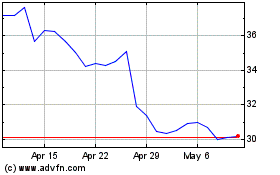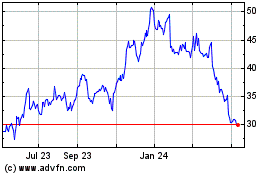By Christopher Mims
To achieve the dream of autonomous vehicles and robots, it's
going to take much more than computer vision and artificial
intelligence. Cars, drones, delivery bots, even our vacuum cleaners
and robot chefs are going to need something that our ancestors
developed millions of years ago: a sense of place.
"I definitely don't think people understand how reliant
autonomous cars are on the fidelity of the map," says Mary
Cummings, a professor of mechanical, electrical and computer
engineering at Duke University. "If the map is wrong then the car
is going to do something wrong."
It turns out that, whether it's Waymo's self-driving cars or the
many auto manufacturers relying on tech from Intel Corp.'s
Mobileye, so-called "autonomous" vehicles are cheating, in a way.
This is also true of models that are already commercially
available, such as Cadillacs with Super Cruise.
Rather than perceiving the world and deciding on the fly what to
do next, these autonomous and semi-autonomous vehicles are
comparing their glimpses of the world with a map stored in memory.
The incredibly detailed maps they rely on are what engineers call a
"world model" of the environment. The model contains things that
don't change very often, from the edges of roads and lanes to the
placement of stop signs, signals, crosswalks and other
infrastructure.
That self-driving cars -- and eventually, all other forms of
autonomous robots -- require such a map has big implications for
who will need to partner with whom in the autonomous driving space.
It implies a great deal of collaboration, or at least licensing,
because the amount of data and engineering required to build these
maps is so gargantuan. It means that, at least for the foreseeable
future, no matter how sophisticated a company's self-driving
technology, it must engage in a massive effort or else partner with
someone capable of making an ultra-detailed map of every road on
which they might drive -- companies like Ushr, TomTom and Here.
In urban environments where global positioning systems can be
inaccurate, a vehicle must navigate by landmarks, says Sam
Abuelsamid, a senior analyst with Navigant research who specializes
in mobility. Once a vehicle is navigating using lidar -- a 3-D
laser view of the environment -- along with cameras and possibly
radar, it can cross-reference certain buildings, lamp posts or
street markings, to identify its stretch of the road down to the
centimeter, he adds.
When the car knows precisely where it is, it can follow
predetermined routes in its memory, simplifying the driving
process. When the Super Cruise system is activated in a Cadillac,
the car stays in its lane by following a route that has been
determined ahead of time, says Christopher Thibodeau, senior vice
president and general manager at Ushr. Ushr makes the Super Cruise
system's maps -- terabytes of map data boiled down to a few hundred
megabytes of relevant route information.
It's not quite as if the car is driving on rails, but it's
close. Mr. Thibodeau says it allows the AI in the car to
concentrate only on the things in its environment that are
changing: cars, pedestrians, unexpected obstacles, construction and
the like.
This is especially important because self-driving is already a
difficult problem both in terms of the number of sensors it
requires and the amount of computing power. A typical fully
autonomous self-driving car is drawing 2,000 to 4,000 extra watts
of power from its electrical system to operate all of its sensors
and computers, Mr. Abuelsamid says.
The car must combine data coming from a variety of sensors -- a
problem called "sensor fusion" that is an area of intense research
-- into a single consensus view of reality.
If something goes wrong, the consequences can be dire. Uber
Technologies Inc.'s self-driving car killed a pedestrian in March,
and more than one Tesla has crashed into the back of a stopped fire
truck at highway speeds, apparently while its Autopilot
driver-assistance system was on.
Before autonomous vehicles can truly be trusted to operate
without human supervision, the computers tasked with driving
according to those maps while looking out for unexpected hazards
must be much more powerful than those in use today, says Mr.
Abuelsamid. Self-driving chips from both Nvidia Corp. and Mobileye
are undergoing rapid leaps in computing power, on the order of a
tenfold improvement every time these firms release a new
iteration.
For Nvidia and Mobileye-owner Intel, this means new
opportunities to enter a market that has long been dominated by
specialist manufacturers of automotive-grade microchips, such as
NXP Semiconductors NV, Mr. Abuelsamid says. But it could also hurt
companies that were early to the race to autonomy, such as Tesla
Inc.
"Frankly both the sensing and compute capabilities that [Tesla's
vehicles] have today are not capable of providing full self-driving
under all conditions, which is what [Chief Executive Elon Musk]
said they could do," says Mr. Abuelsamid. That might change. Mr.
Musk has said that Tesla is developing its own AI chip for
self-driving, and that it will be a "drop-in" replacement for the
existing hardware in its cars. It's not clear when this replacement
computer for Tesla vehicles will arrive.
Eventually, Dr. Cummings says, the hope is that all self-driving
vehicles will contribute to a collective database that updates in
near real-time as roads and conditions change. Mobileye has already
promised to create such a database with camera data coming from its
partners, including Nissan Motor Co., Volkswagen AG and BMW AG.
By the end of 2018, Mobileye will be gathering data from three
million vehicles' forward-facing cameras, which will be compiled
into a database that will be usable for driver assist and
self-driving systems starting in 2019, says Jack Weast, vice
president of autonomous vehicle standards at Mobileye.
Others, such as Waymo, are apparently trying to go it alone,
since data and algorithms are a huge competitive advantage in the
race to fully autonomous driving.
But the cost of such precision mapping sensors at the moment is
very high, says Mr. Thibodeau, adding at least $100,000 to the
price of each vehicle. These systems will become cheaper, but he
believes it will be at least three to five years before they make
it onto the kind of vehicles that private citizens could buy, and
that it will take many years after that for them to achieve
sufficient density on the world's roadways to contribute to
detailed maps suitable for autonomous driving.
How often we re-map all our roads is of critical importance.
Ushr's current database covers about 200,000 miles of
controlled-access highways in North America, and even so, the
amount of roadway that changes in that database is between 6,000
and 8,000 miles a year, says Mr. Thibodeau.
Another challenge for such a system, says Dr. Cummings, is that
any central database used by autonomous vehicles would be a prime
target for hackers. Not only would a breach have dire consequences,
but so would corrupting the map from the outside -- in other words,
attempting to fool autonomous vehicles by changing things in their
environment.
That maps are so critical to self-driving shows, once again,
that the road to fully autonomous fleets is longer than we were
told -- and pushes back the arrival of self-driving cars even
further.
Write to Christopher Mims at christopher.mims@wsj.com
(END) Dow Jones Newswires
October 11, 2018 08:15 ET (12:15 GMT)
Copyright (c) 2018 Dow Jones & Company, Inc.
Intel (NASDAQ:INTC)
Historical Stock Chart
From Mar 2024 to Apr 2024

Intel (NASDAQ:INTC)
Historical Stock Chart
From Apr 2023 to Apr 2024
